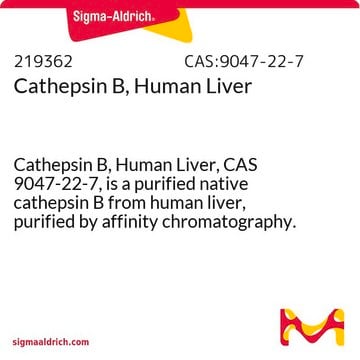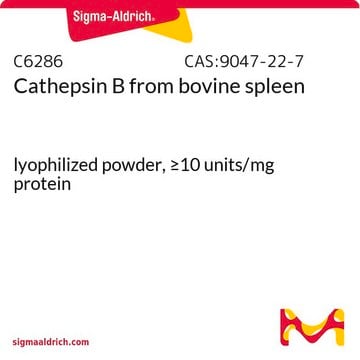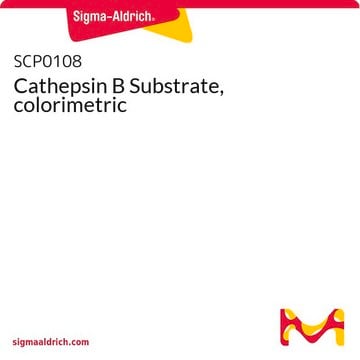219364
Cathepsin B, Human Liver
Cathepsin B, Human Liver, CAS 9047-22-7, is a purified native cathepsin B from human liver, purified by affinity chromatography. Upregulated in many types of tumors.
Sinónimos:
Cathepsin B, Human Liver
About This Item
Productos recomendados
biological source
human liver
Quality Level
assay
>95% (SDS-PAGE)
form
liquid
specific activity
≥50 units/mg protein
purified by
affinity chromatography
manufacturer/tradename
Calbiochem®
storage condition
OK to freeze
avoid repeated freeze/thaw cycles
technique(s)
activity assay: suitable
pH range
3.5—6.0
suitability
suitable for molecular biology
application(s)
life science and biopharma
shipped in
wet ice
storage temp.
−70°C
Gene Information
human ... CTSB(1508)
General description
Cathepsin B, Human Liver, is a native cathepsin B from human liver, purified by affinity chromatography. Cathepsin B is a lysosomal protease with endo/exopeptidase and a carboxydipeptidase activity. It is also known as cysteine cathepsin and belongs to the C1 family of papain-like enzymes. Cathepsin B like H, L, C, X, F, O and V is ubiquitously expressed in human tissues.
Optimal pH: 3.5-6.0.
Application
Biochem/physiol Actions
Packaging
Warning
Unit Definition
Physical form
Preparation Note
Reconstitution
Other Notes
Berquim, I.M., and Sloane, B.F. 1996. Adv. Exp. Med. Biol.389, 281.
Keppler, D., et al. 1994. Biochim. Biophys. Acta.1226, 117.
Musil, D., et al. 1991. EMBO J.10, 2321.
Sloane B.F. 1990. Semin. Cancer Biol.1, 137.
Legal Information
Storage Class
12 - Non Combustible Liquids
wgk_germany
WGK 2
flash_point_f
Not applicable
flash_point_c
Not applicable
Certificados de análisis (COA)
Busque Certificados de análisis (COA) introduciendo el número de lote del producto. Los números de lote se encuentran en la etiqueta del producto después de las palabras «Lot» o «Batch»
¿Ya tiene este producto?
Encuentre la documentación para los productos que ha comprado recientemente en la Biblioteca de documentos.
Nuestro equipo de científicos tiene experiencia en todas las áreas de investigación: Ciencias de la vida, Ciencia de los materiales, Síntesis química, Cromatografía, Analítica y muchas otras.
Póngase en contacto con el Servicio técnico







